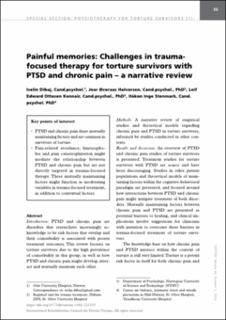| dc.contributor.author | Dibaj, Iselin | |
| dc.contributor.author | Halvorsen, Joar Øveraas | |
| dc.contributor.author | Kennair, Leif Edward Ottesen | |
| dc.contributor.author | Stenmark, Håkon Inge | |
| dc.date.accessioned | 2023-05-15T13:48:24Z | |
| dc.date.available | 2023-05-15T13:48:24Z | |
| dc.date.created | 2020-11-10T20:01:50Z | |
| dc.date.issued | 2020 | |
| dc.identifier.citation | Journal on Rehabilitation of Torture Victims and Prevention of Torture. 2020, 30 (2), 35-57. | en_US |
| dc.identifier.issn | 1018-8185 | |
| dc.identifier.uri | https://hdl.handle.net/11250/3067982 | |
| dc.description.abstract | Introduction: PTSD and chronic pain are disorders that researchers increasingly acknowledge to be risk factors that overlap and their comorbidity is associated with poorer treatment outcomes. This review focuses on torture survivors due to the high prevalence of comorbidity in this group, as well as how PTSD and chronic pain might develop, interact and mutually maintain each other.
Methods: A narrative review of empirical studies and theoretical models regarding chronic pain and PTSD in torture survivors, informed by studies conducted in other contexts.
Results and discussion: An overview of PTSD and chronic pain studies of torture survivors is presented. Treatment studies for torture survivors with PTSD are scarce and have been discouraging. Studies in other patient populations and theoretical models of maintaining factors within the cognitive-behavioral paradigm are presented, and focused around how interactions between PTSD and chronic pain might mitigate treatment of both disorders. Mutually maintaining factors between chronic pain and PTSD are presented as potential barriers to healing, and clinical implications involve suggestions for clinicians with intention to overcome these barriers in trauma-focused treatment of torture survivors. The knowledge base on how chronic pain and PTSD interact within the context of torture is still very limited. Torture is a potent risk factor in itself for both chronic pain and PTSD. Studies point to complex interactions between pain and PTSD across different trauma-exposed populations, especially when the trauma includes pain. Moreover, the coping strategies that are available and might function as some form of protection during torture [e.g. dissociation, withdrawal], might conversely function to exacerbate symptoms when the survivor is in a safe rehabilitation context.
Observations combined with CPPC literature and recent developments in learning theory challenge clinical practice accordingly. Additionally, the limited knowledge base prevents us from providing clear-cut sugges- tions, particularly as the majority of scientific enquiry regarding chronic pain and PTSD has been conducted in other populations outside of the torture survivors group. Furthermore, cultural factors, specific needs and characteristics in this group, the human rights perspective and the socio-political context all need to be acknowledged. Trauma-focused treatment does not appear to specifically target all the mechanisms that are supposedly interacting in maintaining chronic pain and PTSD. Interdisciplinary rehabilitation and close collaboration between physiotherapists and trauma-focused therapists are warranted. | en_US |
| dc.language.iso | eng | en_US |
| dc.publisher | International Rehabilitation Council for Torture Victims | en_US |
| dc.title | Painful memories: Challenges in trauma-focused therapy for torture survivors with PTSD and chronic pain – a narrative review | en_US |
| dc.title.alternative | Painful memories: Challenges in trauma-focused therapy for torture survivors with PTSD and chronic pain – a narrative review | en_US |
| dc.type | Peer reviewed | en_US |
| dc.type | Journal article | en_US |
| dc.description.version | publishedVersion | en_US |
| dc.subject.nsi | VDP::Klinisk psykologi: 262 | en_US |
| dc.subject.nsi | VDP::Clinical psychology: 262 | en_US |
| dc.source.pagenumber | 35-57 | en_US |
| dc.source.volume | 30 | en_US |
| dc.source.journal | Journal on Rehabilitation of Torture Victims and Prevention of Torture | en_US |
| dc.source.issue | 2 | en_US |
| dc.identifier.doi | 10.7146/torture.v30i2.119788 | |
| dc.identifier.cristin | 1846715 | |
| cristin.ispublished | true | |
| cristin.fulltext | original | |
| cristin.qualitycode | 1 | |
